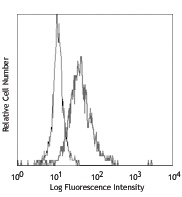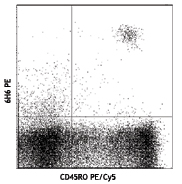- Clone
- L161 (See other available formats)
- Regulatory Status
- RUO
- Workshop
- V T-CD01.18
- Other Names
- R7, M241, BDCA-1
- Isotype
- Mouse IgG1, κ
- Ave. Rating
- Submit a Review
- Product Citations
- publications

-

Human peripheral blood lymphocytes stained with purified L161, followed by anti-mouse IgG FITC
| Cat # | Size | Price | Quantity Check Availability | Save | ||
|---|---|---|---|---|---|---|
| 331501 | 25 µg | 81€ | ||||
| 331502 | 100 µg | 165€ | ||||
CD1c, also known as R7 or M241, is a 43 kD member of the five CD1 antigens (CD1a-e) in humans. The CD1 molecules are type I glycoprotein with structural similarities to MHC class I and are non-covalently associated with β2-microglobulin, belonging to the Ig superfamily. CD1c is expressed on cortical thymocytes, Langerhans cells, dendritic cells, and a subset of B cells. It has been reported that CD1c is also expressed on mature T cells in a tightly regulated manner. CD1c is involved in antigen-presentation of glycolipids. It may also act in T cells as an immune regulatory molecule.
Product DetailsProduct Details
- Reactivity
- Human
- Antibody Type
- Monoclonal
- Host Species
- Mouse
- Formulation
- Phosphate-buffered solution, pH 7.2, containing 0.09% sodium azide.
- Preparation
- The antibody was purified by affinity chromatography.
- Concentration
- 0.5 mg/ml
- Storage & Handling
- The antibody solution should be stored undiluted between 2°C and 8°C.
- Application
-
FC - Quality tested
IHC-F, IHC-P - Reported in the literature, not verified in house - Recommended Usage
-
Each lot of this antibody is quality control tested by immunofluorescent staining with flow cytometric analysis. For flow cytometric staining, the suggested use of this reagent is ≤ 0.5 µg per million cells in 100 µl volume. It is recommended that the reagent be titrated for optimal performance for each application.
- Application Notes
-
Additional reported applications (for the relevant formats) include: immunohistochemical staining on frozen tissue4, 5, formalin-fixed paraffin-embedded immunohistochemical staining6, and spatial biology (IBEX)7,8.
- Application References
-
- del C Salamone M, et al. 2001. J Leukoc Biol. 70:567.
- de Fraissinette A, et al. 1988. Exp Hematol. 16:764.
- Li D, et al. 2012. J Exp Med. 209:109. PubMed
- Xu C, et al. 2010. Am J Hematol. 85:539 (IHC-F)
- Gerlini G, et al. 2001. J Invest Dermatol. 117:576 (IHC-F)
- Poposki J, et al. 2016. Clin Exp Allergy 45:384 (IHC-P) PubMed
- Radtke AJ, et al. 2020. Proc Natl Acad Sci USA. 117:33455-33465. (SB) PubMed
- Radtke AJ, et al. 2022. Nat Protoc. 17:378-401. (SB) PubMed
- Product Citations
- RRID
-
AB_1088996 (BioLegend Cat. No. 331501)
AB_1088995 (BioLegend Cat. No. 331502)
Antigen Details
- Structure
- 43 kD, Ig superfamily, MHC I-like molecule, associates with β2-microglobulin
- Distribution
-
B cell subset, cortical thymocytes, dendritic cells, and Langerhans cells
- Function
- Presents lipid antigen to CD1c-restricted T cells
- Ligand/Receptor
- CD1c-restricted TCR
- Cell Type
- B cells, Dendritic cells, Langerhans cells, Thymocytes
- Biology Area
- Immunology
- Molecular Family
- CD Molecules
- Antigen References
-
1. Fainboim LM and del C. Salamone. 2002. J. Biol. Reg. Homeos. Ag. 16:125.
2. M. del Salamone C, et al. 2001. J. Leukocyte Biol. 70:567.
3. Zola H, et al. Eds. 2007. Leukocyte and Stromal Cell Molecules:The CD Markers. P42. - Gene ID
- 911 View all products for this Gene ID
- UniProt
- View information about CD1c on UniProt.org
Related Pages & Pathways
Pages
Customers Also Purchased
Compare Data Across All Formats
This data display is provided for general comparisons between formats.
Your actual data may vary due to variations in samples, target cells, instruments and their settings, staining conditions, and other factors.
If you need assistance with selecting the best format contact our expert technical support team.
 Login / Register
Login / Register 












Follow Us